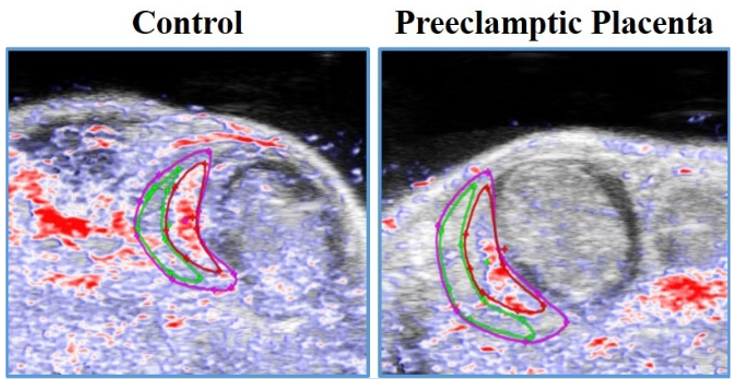Accurately measuring placental oxygenation levels in real time, using noninvasive methods, is important for detecting preeclampsia (a pregnancy-associated high blood pressure disorder), fetal growth restriction (a condition where a fetus does not reach the appropriate weight), and other health problems. Currently, healthcare providers do not have a way to measure whether the oxygen levels in the placenta could indicate a possible complication. Researchers supported by NICHD through the Human Placenta Project (HPP) are studying the use of photoacoustic imaging (PAI) to measure placental oxygenation and identify high-risk pregnancies.
Understanding Placental Oxygenation
Placental oxygenation, which refers to the oxygen saturation levels in the placenta, is a key factor in the development of healthy pregnancies. It also varies throughout the gestation period. Later in pregnancy, oxygenation levels increase to support the growing placenta and fetus. However, abnormal vascular remodeling can lead to a series of changes in placental oxygenation that are thought to be associated with a subset of preeclamptic pregnancies. Detecting changes in placental oxygenation throughout pregnancy may help healthcare providers identify and treat problems early.

Credit: Liliya M. Yamaleyeva, M.D., M.S., FAHA
Determining the Sensitivity of 3D Ultrasound-Guided Photoacoustic Imaging
Photoacoustic imaging is an experimental imaging tool that combines the best of two technologies. It obtains strong optical contrast by using photoacoustic laser technology, and it has high spatial resolution from ultrasound. A laser sends pulsed signals to the tissue, and absorbed light is converted into heat, resulting in thermal expansion of tissue. The resultant sound waves are detected by ultrasound. Differences in absorption spectra between oxygenated and deoxygenated hemoglobin in the blood allow for the measurement of vessel oxygen saturation.
The researchers hypothesized that three-dimensional photoacoustic imaging can noninvasively, accurately, and reliably assess placental oxygenation throughout pregnancy. In one study, the sensitivity of photoacoustic technique was tested (1) in vitro,by showing a positive relationship between oxygen saturation levels measured by blood gas analyzer and those recorded from the imaging phantom and (2) in vivo, by applying a maternal hyperoxygenation test and recording regional variations in placental oxygenation in mice. Furthermore, the team demonstrated, in a mouse model, that the technique was sensitive in measuring variations in placental oxygenation levels throughout normal pregnancy, pregnancy with placental insufficiency, and hypertensive pregnancy with features of preeclampsia.
Analyzing Regional Placental Hemodynamics
Recent findings 
Initial Research Implications
Monitoring placental oxygen saturation throughout pregnancy can help detect changes in placental oxygenation that are associated with some pregnancy complications. Three-dimensional photoacoustic imaging more accurately reflects oxygen saturation and hemoglobin concentrations than two-dimensional imaging does. Longitudinal measurements of placental oxygenation may help identify pregnancy complications at early stages, before the development of complications. A next step would involve translating photoacoustic ultrasound used successfully in mice to humans. Doing would enable the technology to be used in pregnancy management in the future.
Learn more about the team
Principal Investigator(s):
Learn more about the HPP-funded project:
Longitudinal Assessments of Placental Oxygenation and Perfusion Using Ultrasound and Photoacoustics
 BACK TO TOP
BACK TO TOP